Managing and Running a Small Business: HND Report 2020-2021
VerifiedAdded on 2022/11/30
|12
|3501
|199
Report
AI Summary
This report delves into the core aspects of managing and running a small business, addressing key considerations for planning and allocating resources, particularly within the context of a social enterprise. It explores customer relationship management processes, evaluating various strategies and their effectiveness. The report then examines the implications of transnational business development, weighing the advantages and disadvantages. A significant portion is dedicated to financial analysis, including the creation of an itemized cash flow forecast, the application of break-even analysis, and the interpretation of key financial statements to assess a company's successful management. The report also discusses relevant legislation and regulations impacting social enterprises. The case study is a social enterprise called Migrateful, which operates in London, Kent and Bristol, and the report provides an in-depth analysis of its financial and operational aspects.
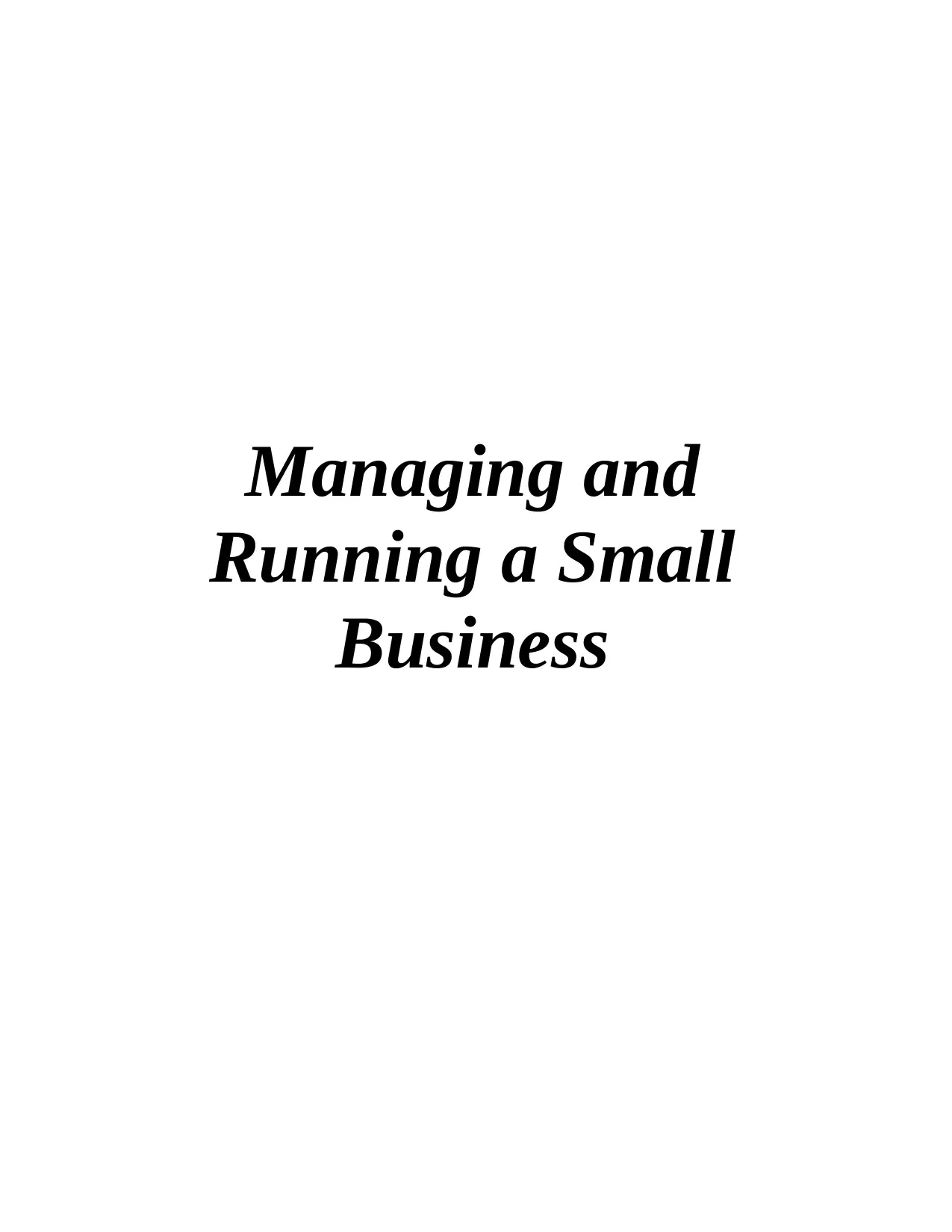
Managing and
Running a Small
Business
Running a Small
Business
Paraphrase This Document
Need a fresh take? Get an instant paraphrase of this document with our AI Paraphraser
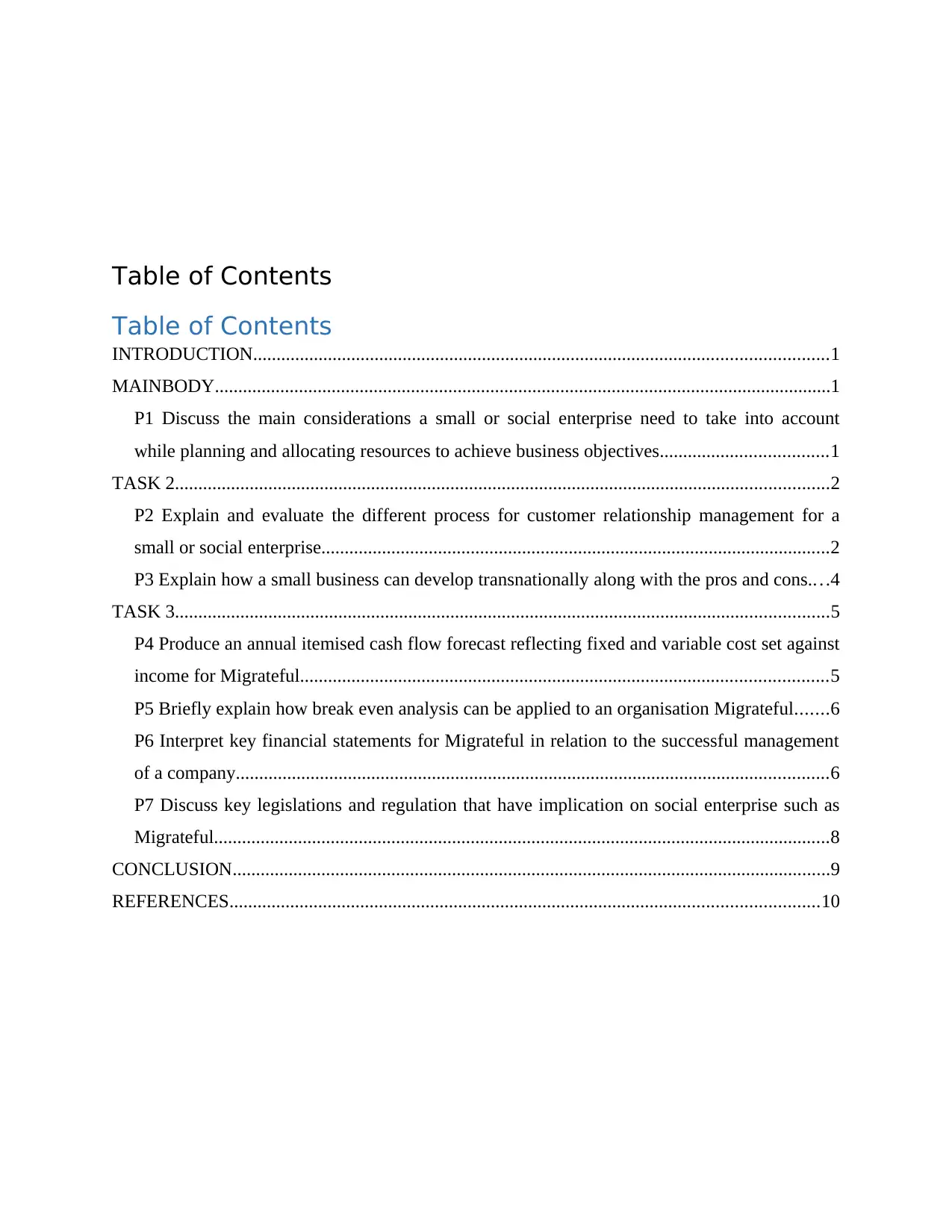
Table of Contents
Table of Contents
INTRODUCTION...........................................................................................................................1
MAINBODY....................................................................................................................................1
P1 Discuss the main considerations a small or social enterprise need to take into account
while planning and allocating resources to achieve business objectives....................................1
TASK 2............................................................................................................................................2
P2 Explain and evaluate the different process for customer relationship management for a
small or social enterprise.............................................................................................................2
P3 Explain how a small business can develop transnationally along with the pros and cons....4
TASK 3............................................................................................................................................5
P4 Produce an annual itemised cash flow forecast reflecting fixed and variable cost set against
income for Migrateful.................................................................................................................5
P5 Briefly explain how break even analysis can be applied to an organisation Migrateful.......6
P6 Interpret key financial statements for Migrateful in relation to the successful management
of a company...............................................................................................................................6
P7 Discuss key legislations and regulation that have implication on social enterprise such as
Migrateful....................................................................................................................................8
CONCLUSION................................................................................................................................9
REFERENCES..............................................................................................................................10
Table of Contents
INTRODUCTION...........................................................................................................................1
MAINBODY....................................................................................................................................1
P1 Discuss the main considerations a small or social enterprise need to take into account
while planning and allocating resources to achieve business objectives....................................1
TASK 2............................................................................................................................................2
P2 Explain and evaluate the different process for customer relationship management for a
small or social enterprise.............................................................................................................2
P3 Explain how a small business can develop transnationally along with the pros and cons....4
TASK 3............................................................................................................................................5
P4 Produce an annual itemised cash flow forecast reflecting fixed and variable cost set against
income for Migrateful.................................................................................................................5
P5 Briefly explain how break even analysis can be applied to an organisation Migrateful.......6
P6 Interpret key financial statements for Migrateful in relation to the successful management
of a company...............................................................................................................................6
P7 Discuss key legislations and regulation that have implication on social enterprise such as
Migrateful....................................................................................................................................8
CONCLUSION................................................................................................................................9
REFERENCES..............................................................................................................................10
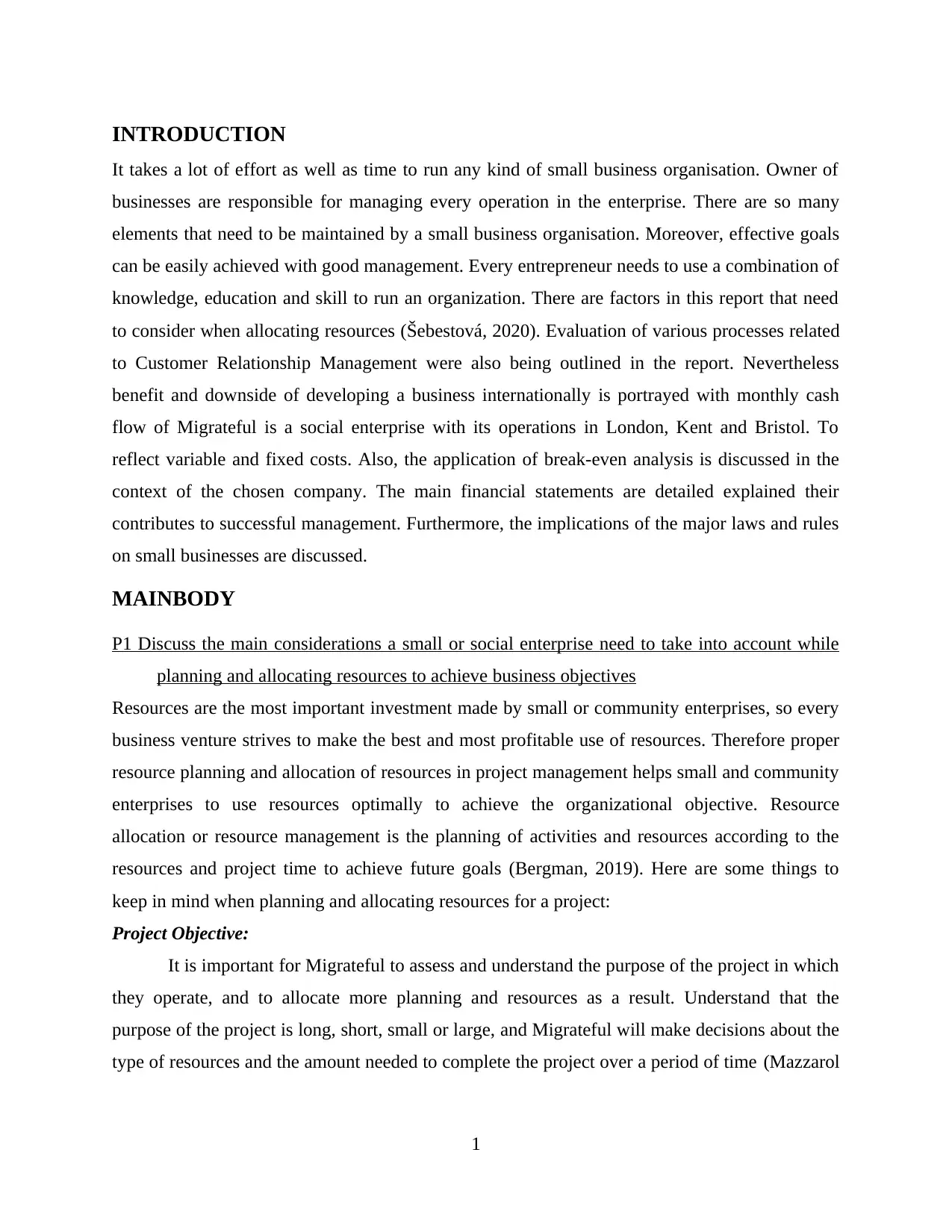
INTRODUCTION
It takes a lot of effort as well as time to run any kind of small business organisation. Owner of
businesses are responsible for managing every operation in the enterprise. There are so many
elements that need to be maintained by a small business organisation. Moreover, effective goals
can be easily achieved with good management. Every entrepreneur needs to use a combination of
knowledge, education and skill to run an organization. There are factors in this report that need
to consider when allocating resources (Šebestová, 2020). Evaluation of various processes related
to Customer Relationship Management were also being outlined in the report. Nevertheless
benefit and downside of developing a business internationally is portrayed with monthly cash
flow of Migrateful is a social enterprise with its operations in London, Kent and Bristol. To
reflect variable and fixed costs. Also, the application of break-even analysis is discussed in the
context of the chosen company. The main financial statements are detailed explained their
contributes to successful management. Furthermore, the implications of the major laws and rules
on small businesses are discussed.
MAINBODY
P1 Discuss the main considerations a small or social enterprise need to take into account while
planning and allocating resources to achieve business objectives
Resources are the most important investment made by small or community enterprises, so every
business venture strives to make the best and most profitable use of resources. Therefore proper
resource planning and allocation of resources in project management helps small and community
enterprises to use resources optimally to achieve the organizational objective. Resource
allocation or resource management is the planning of activities and resources according to the
resources and project time to achieve future goals (Bergman, 2019). Here are some things to
keep in mind when planning and allocating resources for a project:
Project Objective:
It is important for Migrateful to assess and understand the purpose of the project in which
they operate, and to allocate more planning and resources as a result. Understand that the
purpose of the project is long, short, small or large, and Migrateful will make decisions about the
type of resources and the amount needed to complete the project over a period of time (Mazzarol
1
It takes a lot of effort as well as time to run any kind of small business organisation. Owner of
businesses are responsible for managing every operation in the enterprise. There are so many
elements that need to be maintained by a small business organisation. Moreover, effective goals
can be easily achieved with good management. Every entrepreneur needs to use a combination of
knowledge, education and skill to run an organization. There are factors in this report that need
to consider when allocating resources (Šebestová, 2020). Evaluation of various processes related
to Customer Relationship Management were also being outlined in the report. Nevertheless
benefit and downside of developing a business internationally is portrayed with monthly cash
flow of Migrateful is a social enterprise with its operations in London, Kent and Bristol. To
reflect variable and fixed costs. Also, the application of break-even analysis is discussed in the
context of the chosen company. The main financial statements are detailed explained their
contributes to successful management. Furthermore, the implications of the major laws and rules
on small businesses are discussed.
MAINBODY
P1 Discuss the main considerations a small or social enterprise need to take into account while
planning and allocating resources to achieve business objectives
Resources are the most important investment made by small or community enterprises, so every
business venture strives to make the best and most profitable use of resources. Therefore proper
resource planning and allocation of resources in project management helps small and community
enterprises to use resources optimally to achieve the organizational objective. Resource
allocation or resource management is the planning of activities and resources according to the
resources and project time to achieve future goals (Bergman, 2019). Here are some things to
keep in mind when planning and allocating resources for a project:
Project Objective:
It is important for Migrateful to assess and understand the purpose of the project in which
they operate, and to allocate more planning and resources as a result. Understand that the
purpose of the project is long, short, small or large, and Migrateful will make decisions about the
type of resources and the amount needed to complete the project over a period of time (Mazzarol
1
⊘ This is a preview!⊘
Do you want full access?
Subscribe today to unlock all pages.

Trusted by 1+ million students worldwide
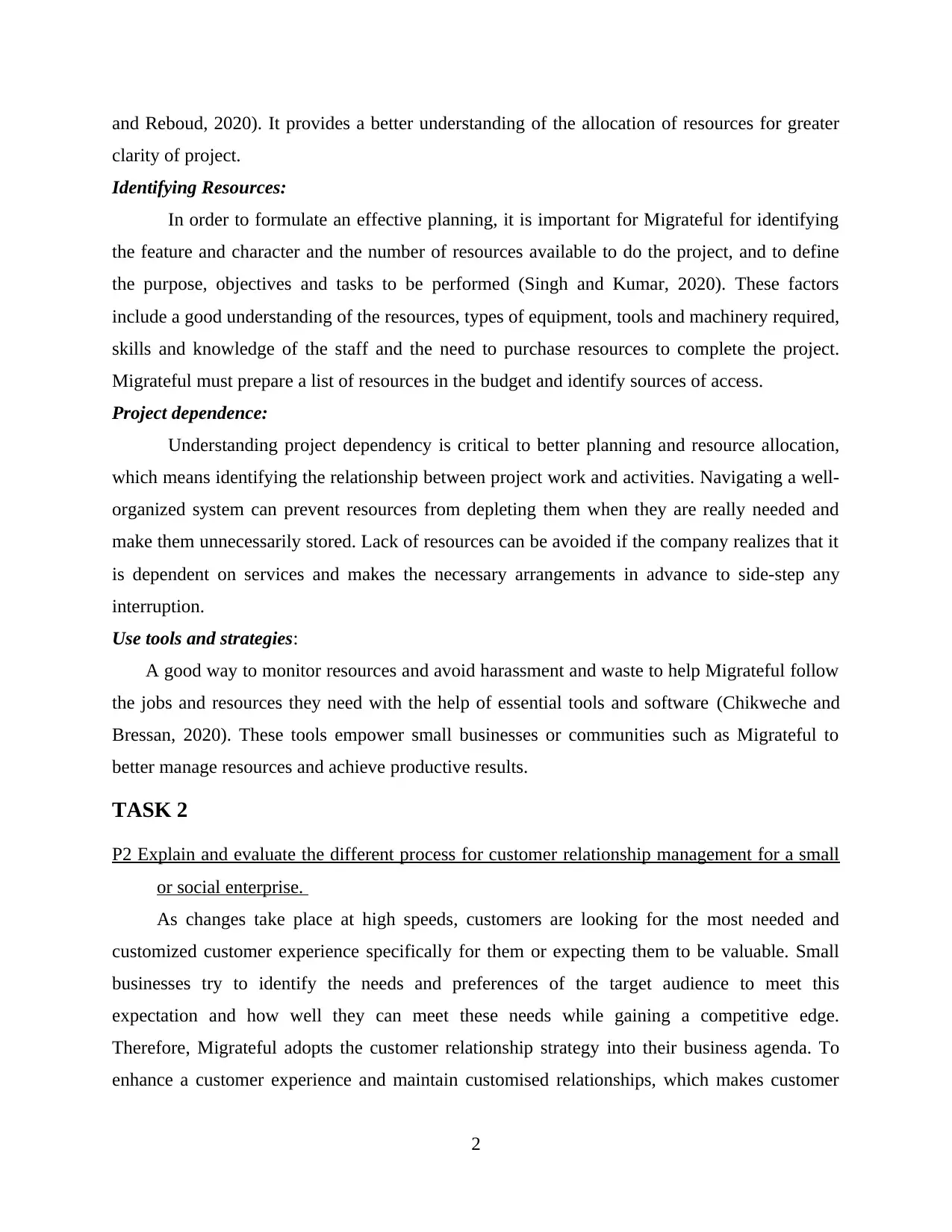
and Reboud, 2020). It provides a better understanding of the allocation of resources for greater
clarity of project.
Identifying Resources:
In order to formulate an effective planning, it is important for Migrateful for identifying
the feature and character and the number of resources available to do the project, and to define
the purpose, objectives and tasks to be performed (Singh and Kumar, 2020). These factors
include a good understanding of the resources, types of equipment, tools and machinery required,
skills and knowledge of the staff and the need to purchase resources to complete the project.
Migrateful must prepare a list of resources in the budget and identify sources of access.
Project dependence:
Understanding project dependency is critical to better planning and resource allocation,
which means identifying the relationship between project work and activities. Navigating a well-
organized system can prevent resources from depleting them when they are really needed and
make them unnecessarily stored. Lack of resources can be avoided if the company realizes that it
is dependent on services and makes the necessary arrangements in advance to side-step any
interruption.
Use tools and strategies:
A good way to monitor resources and avoid harassment and waste to help Migrateful follow
the jobs and resources they need with the help of essential tools and software (Chikweche and
Bressan, 2020). These tools empower small businesses or communities such as Migrateful to
better manage resources and achieve productive results.
TASK 2
P2 Explain and evaluate the different process for customer relationship management for a small
or social enterprise.
As changes take place at high speeds, customers are looking for the most needed and
customized customer experience specifically for them or expecting them to be valuable. Small
businesses try to identify the needs and preferences of the target audience to meet this
expectation and how well they can meet these needs while gaining a competitive edge.
Therefore, Migrateful adopts the customer relationship strategy into their business agenda. To
enhance a customer experience and maintain customised relationships, which makes customer
2
clarity of project.
Identifying Resources:
In order to formulate an effective planning, it is important for Migrateful for identifying
the feature and character and the number of resources available to do the project, and to define
the purpose, objectives and tasks to be performed (Singh and Kumar, 2020). These factors
include a good understanding of the resources, types of equipment, tools and machinery required,
skills and knowledge of the staff and the need to purchase resources to complete the project.
Migrateful must prepare a list of resources in the budget and identify sources of access.
Project dependence:
Understanding project dependency is critical to better planning and resource allocation,
which means identifying the relationship between project work and activities. Navigating a well-
organized system can prevent resources from depleting them when they are really needed and
make them unnecessarily stored. Lack of resources can be avoided if the company realizes that it
is dependent on services and makes the necessary arrangements in advance to side-step any
interruption.
Use tools and strategies:
A good way to monitor resources and avoid harassment and waste to help Migrateful follow
the jobs and resources they need with the help of essential tools and software (Chikweche and
Bressan, 2020). These tools empower small businesses or communities such as Migrateful to
better manage resources and achieve productive results.
TASK 2
P2 Explain and evaluate the different process for customer relationship management for a small
or social enterprise.
As changes take place at high speeds, customers are looking for the most needed and
customized customer experience specifically for them or expecting them to be valuable. Small
businesses try to identify the needs and preferences of the target audience to meet this
expectation and how well they can meet these needs while gaining a competitive edge.
Therefore, Migrateful adopts the customer relationship strategy into their business agenda. To
enhance a customer experience and maintain customised relationships, which makes customer
2
Paraphrase This Document
Need a fresh take? Get an instant paraphrase of this document with our AI Paraphraser
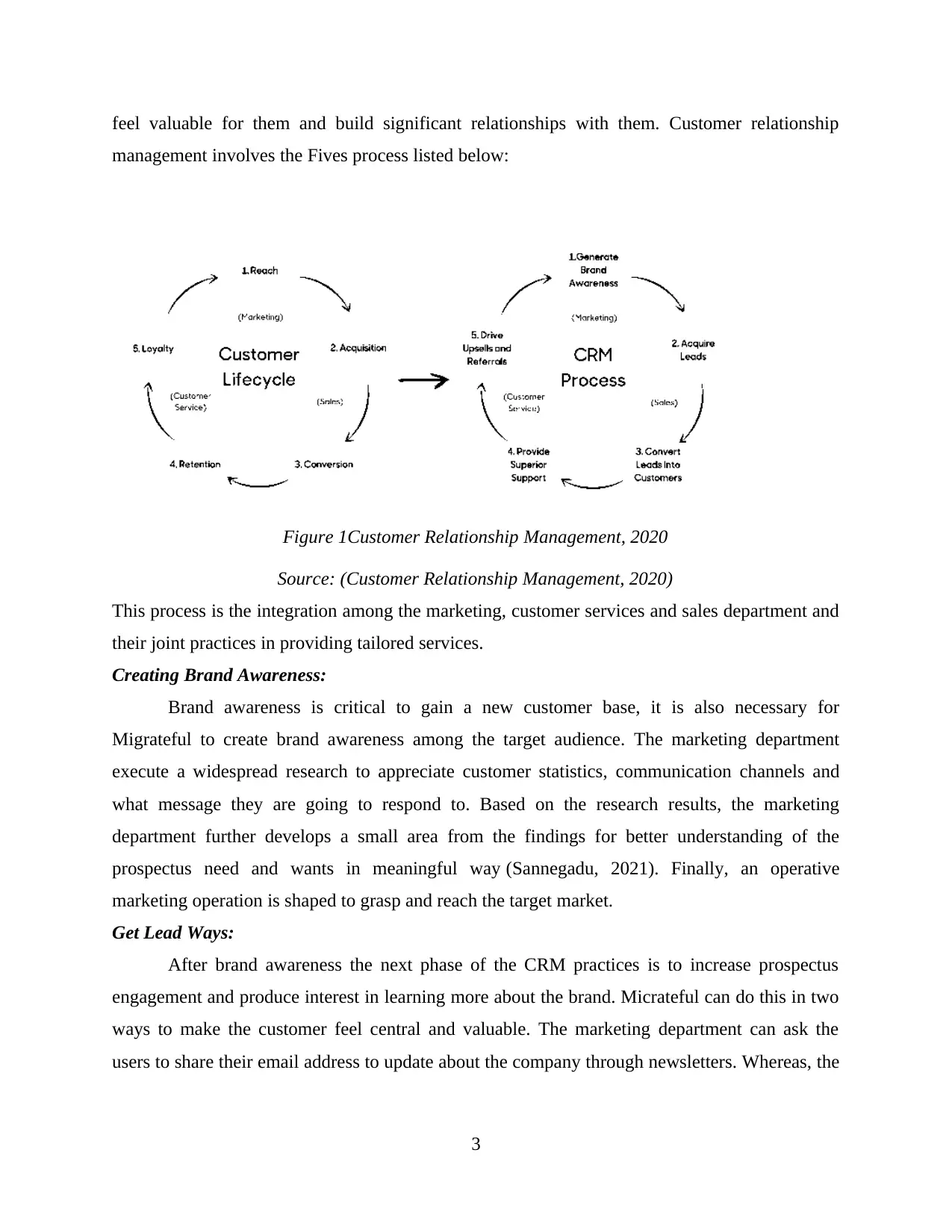
feel valuable for them and build significant relationships with them. Customer relationship
management involves the Fives process listed below:
Figure 1Customer Relationship Management, 2020
Source: (Customer Relationship Management, 2020)
This process is the integration among the marketing, customer services and sales department and
their joint practices in providing tailored services.
Creating Brand Awareness:
Brand awareness is critical to gain a new customer base, it is also necessary for
Migrateful to create brand awareness among the target audience. The marketing department
execute a widespread research to appreciate customer statistics, communication channels and
what message they are going to respond to. Based on the research results, the marketing
department further develops a small area from the findings for better understanding of the
prospectus need and wants in meaningful way (Sannegadu, 2021). Finally, an operative
marketing operation is shaped to grasp and reach the target market.
Get Lead Ways:
After brand awareness the next phase of the CRM practices is to increase prospectus
engagement and produce interest in learning more about the brand. Micrateful can do this in two
ways to make the customer feel central and valuable. The marketing department can ask the
users to share their email address to update about the company through newsletters. Whereas, the
3
management involves the Fives process listed below:
Figure 1Customer Relationship Management, 2020
Source: (Customer Relationship Management, 2020)
This process is the integration among the marketing, customer services and sales department and
their joint practices in providing tailored services.
Creating Brand Awareness:
Brand awareness is critical to gain a new customer base, it is also necessary for
Migrateful to create brand awareness among the target audience. The marketing department
execute a widespread research to appreciate customer statistics, communication channels and
what message they are going to respond to. Based on the research results, the marketing
department further develops a small area from the findings for better understanding of the
prospectus need and wants in meaningful way (Sannegadu, 2021). Finally, an operative
marketing operation is shaped to grasp and reach the target market.
Get Lead Ways:
After brand awareness the next phase of the CRM practices is to increase prospectus
engagement and produce interest in learning more about the brand. Micrateful can do this in two
ways to make the customer feel central and valuable. The marketing department can ask the
users to share their email address to update about the company through newsletters. Whereas, the
3
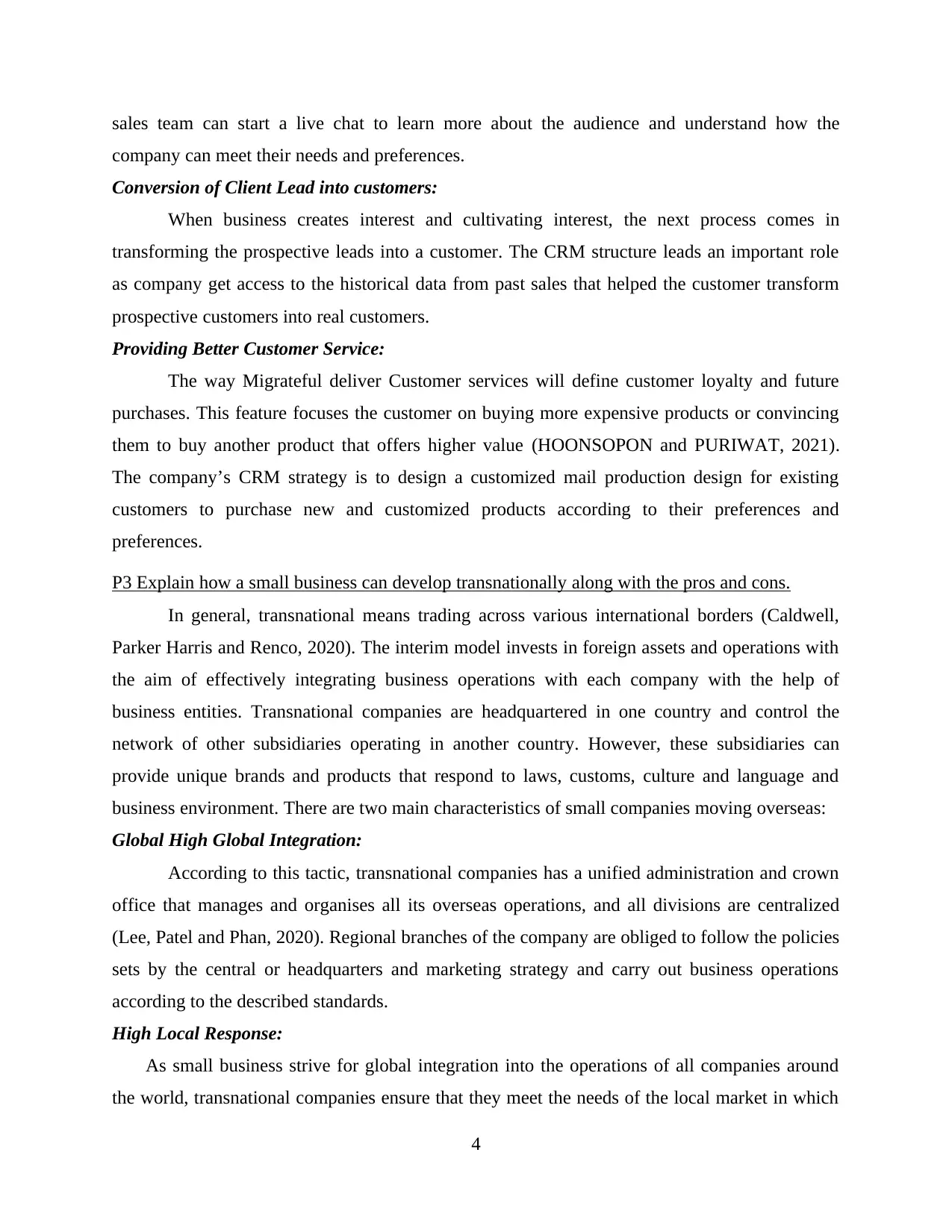
sales team can start a live chat to learn more about the audience and understand how the
company can meet their needs and preferences.
Conversion of Client Lead into customers:
When business creates interest and cultivating interest, the next process comes in
transforming the prospective leads into a customer. The CRM structure leads an important role
as company get access to the historical data from past sales that helped the customer transform
prospective customers into real customers.
Providing Better Customer Service:
The way Migrateful deliver Customer services will define customer loyalty and future
purchases. This feature focuses the customer on buying more expensive products or convincing
them to buy another product that offers higher value (HOONSOPON and PURIWAT, 2021).
The company’s CRM strategy is to design a customized mail production design for existing
customers to purchase new and customized products according to their preferences and
preferences.
P3 Explain how a small business can develop transnationally along with the pros and cons.
In general, transnational means trading across various international borders (Caldwell,
Parker Harris and Renco, 2020). The interim model invests in foreign assets and operations with
the aim of effectively integrating business operations with each company with the help of
business entities. Transnational companies are headquartered in one country and control the
network of other subsidiaries operating in another country. However, these subsidiaries can
provide unique brands and products that respond to laws, customs, culture and language and
business environment. There are two main characteristics of small companies moving overseas:
Global High Global Integration:
According to this tactic, transnational companies has a unified administration and crown
office that manages and organises all its overseas operations, and all divisions are centralized
(Lee, Patel and Phan, 2020). Regional branches of the company are obliged to follow the policies
sets by the central or headquarters and marketing strategy and carry out business operations
according to the described standards.
High Local Response:
As small business strive for global integration into the operations of all companies around
the world, transnational companies ensure that they meet the needs of the local market in which
4
company can meet their needs and preferences.
Conversion of Client Lead into customers:
When business creates interest and cultivating interest, the next process comes in
transforming the prospective leads into a customer. The CRM structure leads an important role
as company get access to the historical data from past sales that helped the customer transform
prospective customers into real customers.
Providing Better Customer Service:
The way Migrateful deliver Customer services will define customer loyalty and future
purchases. This feature focuses the customer on buying more expensive products or convincing
them to buy another product that offers higher value (HOONSOPON and PURIWAT, 2021).
The company’s CRM strategy is to design a customized mail production design for existing
customers to purchase new and customized products according to their preferences and
preferences.
P3 Explain how a small business can develop transnationally along with the pros and cons.
In general, transnational means trading across various international borders (Caldwell,
Parker Harris and Renco, 2020). The interim model invests in foreign assets and operations with
the aim of effectively integrating business operations with each company with the help of
business entities. Transnational companies are headquartered in one country and control the
network of other subsidiaries operating in another country. However, these subsidiaries can
provide unique brands and products that respond to laws, customs, culture and language and
business environment. There are two main characteristics of small companies moving overseas:
Global High Global Integration:
According to this tactic, transnational companies has a unified administration and crown
office that manages and organises all its overseas operations, and all divisions are centralized
(Lee, Patel and Phan, 2020). Regional branches of the company are obliged to follow the policies
sets by the central or headquarters and marketing strategy and carry out business operations
according to the described standards.
High Local Response:
As small business strive for global integration into the operations of all companies around
the world, transnational companies ensure that they meet the needs of the local market in which
4
⊘ This is a preview!⊘
Do you want full access?
Subscribe today to unlock all pages.

Trusted by 1+ million students worldwide
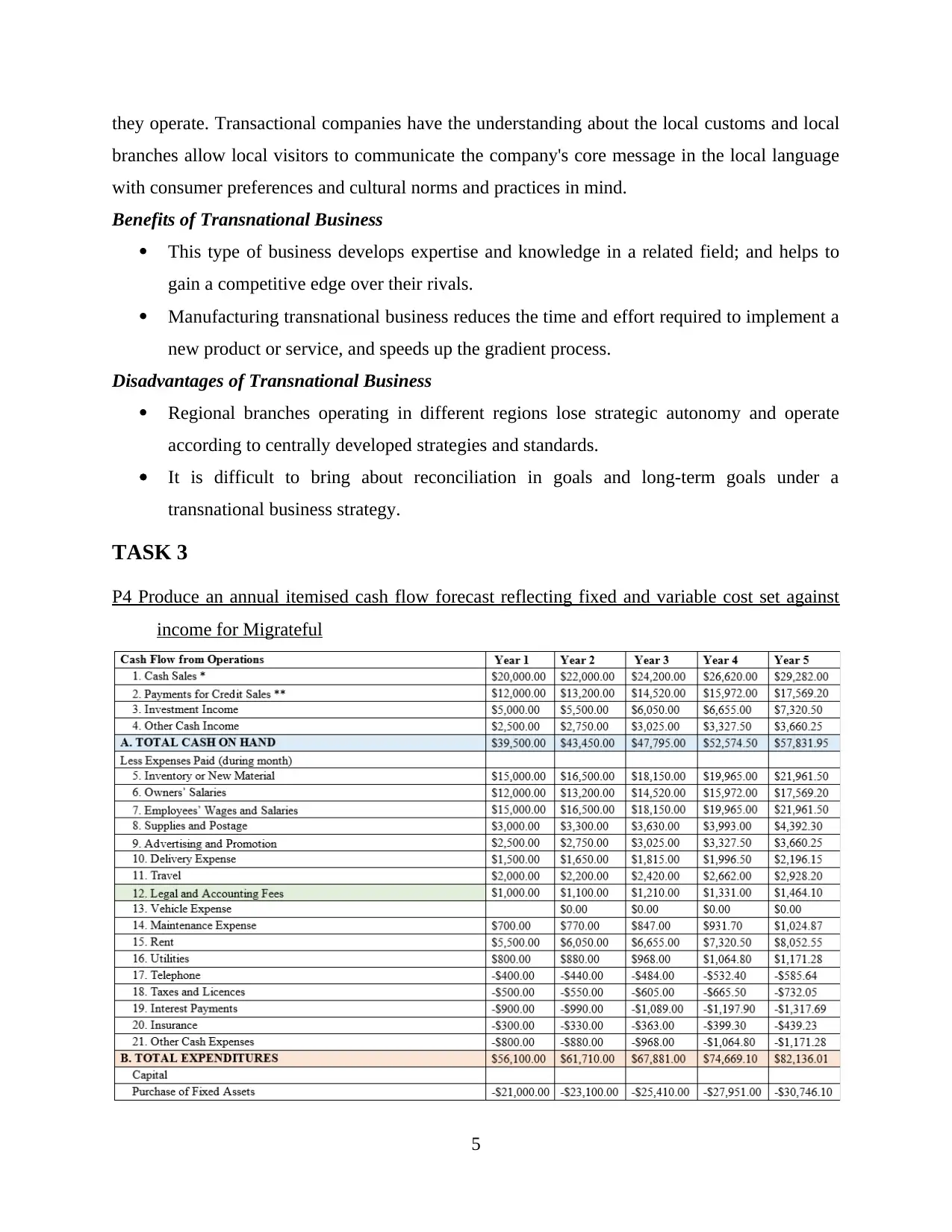
they operate. Transactional companies have the understanding about the local customs and local
branches allow local visitors to communicate the company's core message in the local language
with consumer preferences and cultural norms and practices in mind.
Benefits of Transnational Business
This type of business develops expertise and knowledge in a related field; and helps to
gain a competitive edge over their rivals.
Manufacturing transnational business reduces the time and effort required to implement a
new product or service, and speeds up the gradient process.
Disadvantages of Transnational Business
Regional branches operating in different regions lose strategic autonomy and operate
according to centrally developed strategies and standards.
It is difficult to bring about reconciliation in goals and long-term goals under a
transnational business strategy.
TASK 3
P4 Produce an annual itemised cash flow forecast reflecting fixed and variable cost set against
income for Migrateful
5
branches allow local visitors to communicate the company's core message in the local language
with consumer preferences and cultural norms and practices in mind.
Benefits of Transnational Business
This type of business develops expertise and knowledge in a related field; and helps to
gain a competitive edge over their rivals.
Manufacturing transnational business reduces the time and effort required to implement a
new product or service, and speeds up the gradient process.
Disadvantages of Transnational Business
Regional branches operating in different regions lose strategic autonomy and operate
according to centrally developed strategies and standards.
It is difficult to bring about reconciliation in goals and long-term goals under a
transnational business strategy.
TASK 3
P4 Produce an annual itemised cash flow forecast reflecting fixed and variable cost set against
income for Migrateful
5
Paraphrase This Document
Need a fresh take? Get an instant paraphrase of this document with our AI Paraphraser
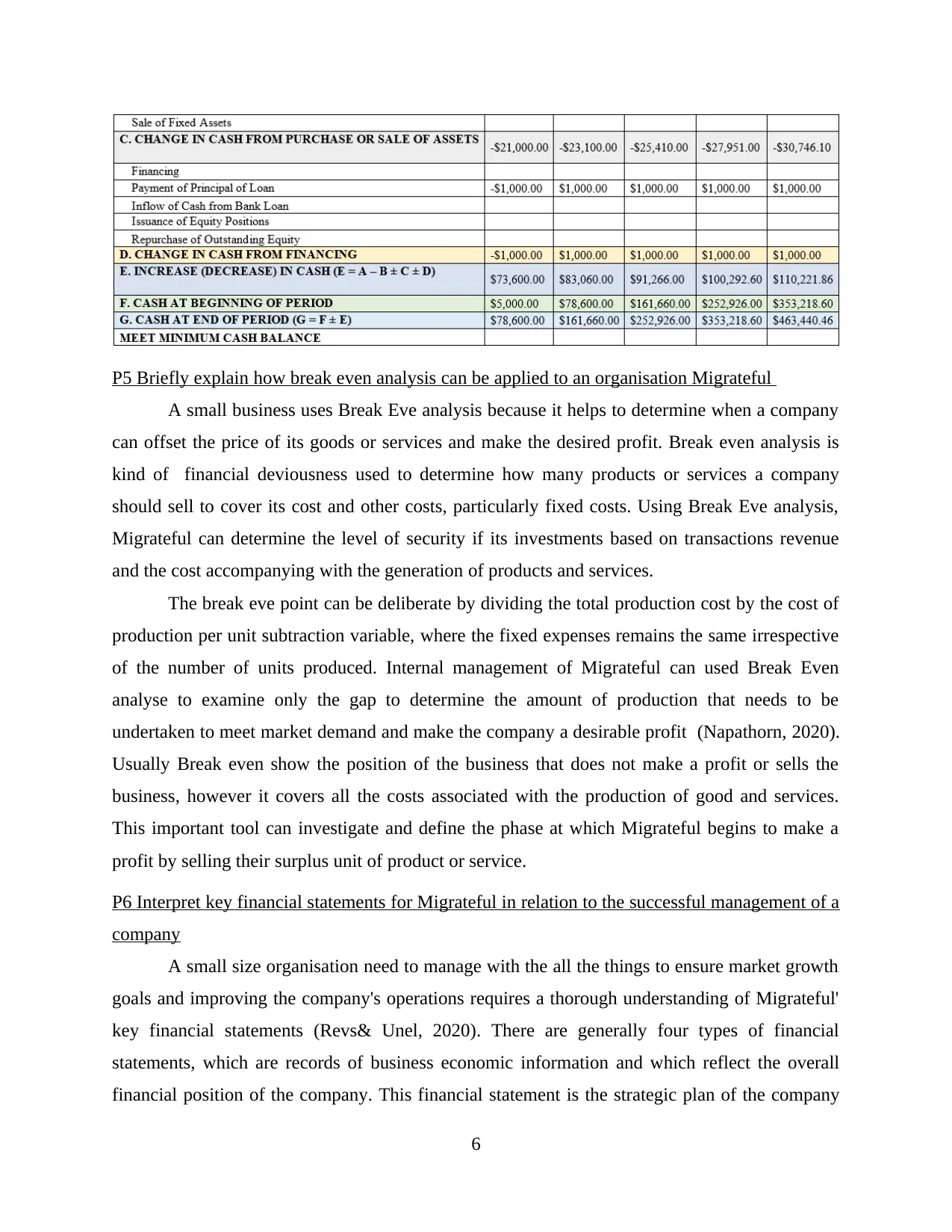
P5 Briefly explain how break even analysis can be applied to an organisation Migrateful
A small business uses Break Eve analysis because it helps to determine when a company
can offset the price of its goods or services and make the desired profit. Break even analysis is
kind of financial deviousness used to determine how many products or services a company
should sell to cover its cost and other costs, particularly fixed costs. Using Break Eve analysis,
Migrateful can determine the level of security if its investments based on transactions revenue
and the cost accompanying with the generation of products and services.
The break eve point can be deliberate by dividing the total production cost by the cost of
production per unit subtraction variable, where the fixed expenses remains the same irrespective
of the number of units produced. Internal management of Migrateful can used Break Even
analyse to examine only the gap to determine the amount of production that needs to be
undertaken to meet market demand and make the company a desirable profit (Napathorn, 2020).
Usually Break even show the position of the business that does not make a profit or sells the
business, however it covers all the costs associated with the production of good and services.
This important tool can investigate and define the phase at which Migrateful begins to make a
profit by selling their surplus unit of product or service.
P6 Interpret key financial statements for Migrateful in relation to the successful management of a
company
A small size organisation need to manage with the all the things to ensure market growth
goals and improving the company's operations requires a thorough understanding of Migrateful'
key financial statements (Revs& Unel, 2020). There are generally four types of financial
statements, which are records of business economic information and which reflect the overall
financial position of the company. This financial statement is the strategic plan of the company
6
A small business uses Break Eve analysis because it helps to determine when a company
can offset the price of its goods or services and make the desired profit. Break even analysis is
kind of financial deviousness used to determine how many products or services a company
should sell to cover its cost and other costs, particularly fixed costs. Using Break Eve analysis,
Migrateful can determine the level of security if its investments based on transactions revenue
and the cost accompanying with the generation of products and services.
The break eve point can be deliberate by dividing the total production cost by the cost of
production per unit subtraction variable, where the fixed expenses remains the same irrespective
of the number of units produced. Internal management of Migrateful can used Break Even
analyse to examine only the gap to determine the amount of production that needs to be
undertaken to meet market demand and make the company a desirable profit (Napathorn, 2020).
Usually Break even show the position of the business that does not make a profit or sells the
business, however it covers all the costs associated with the production of good and services.
This important tool can investigate and define the phase at which Migrateful begins to make a
profit by selling their surplus unit of product or service.
P6 Interpret key financial statements for Migrateful in relation to the successful management of a
company
A small size organisation need to manage with the all the things to ensure market growth
goals and improving the company's operations requires a thorough understanding of Migrateful'
key financial statements (Revs& Unel, 2020). There are generally four types of financial
statements, which are records of business economic information and which reflect the overall
financial position of the company. This financial statement is the strategic plan of the company
6
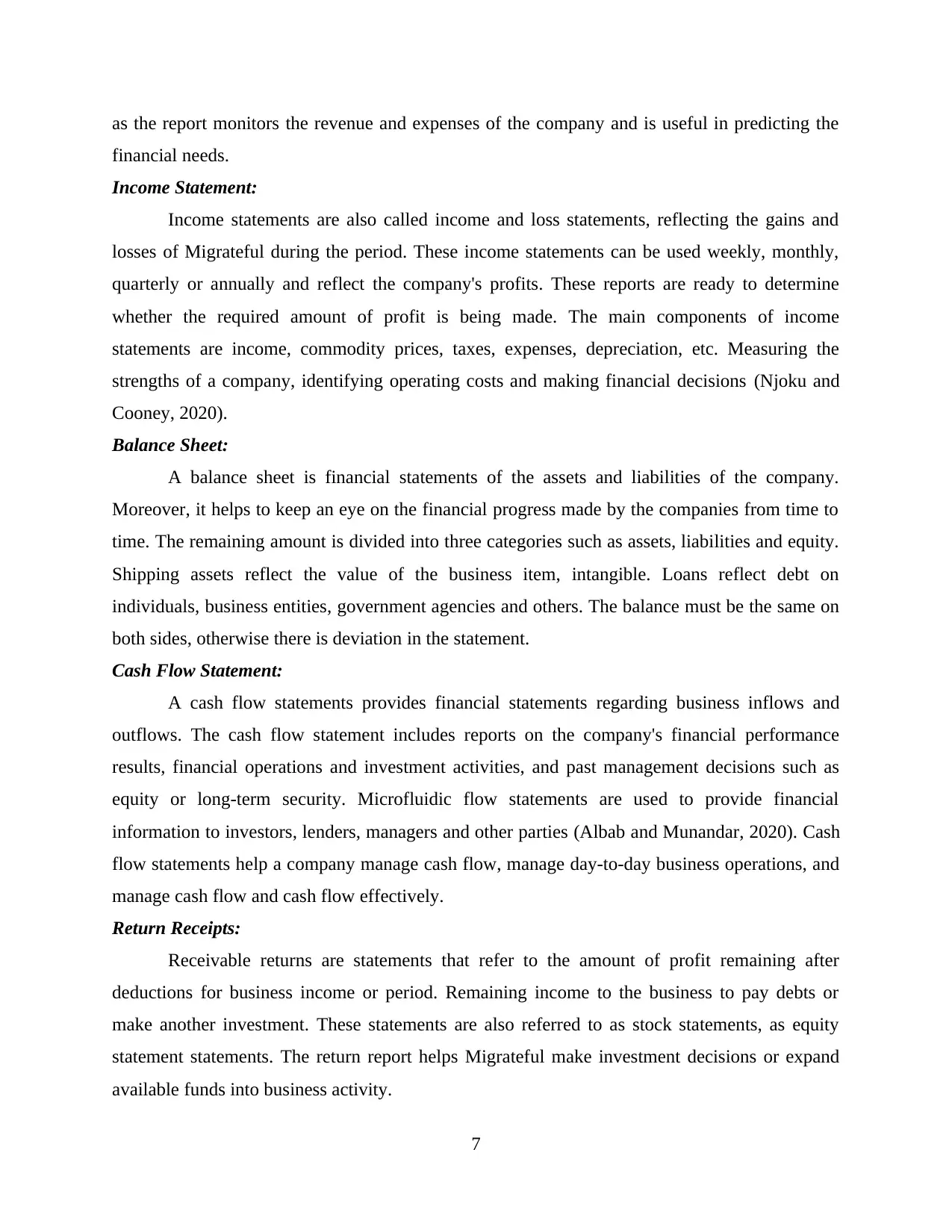
as the report monitors the revenue and expenses of the company and is useful in predicting the
financial needs.
Income Statement:
Income statements are also called income and loss statements, reflecting the gains and
losses of Migrateful during the period. These income statements can be used weekly, monthly,
quarterly or annually and reflect the company's profits. These reports are ready to determine
whether the required amount of profit is being made. The main components of income
statements are income, commodity prices, taxes, expenses, depreciation, etc. Measuring the
strengths of a company, identifying operating costs and making financial decisions (Njoku and
Cooney, 2020).
Balance Sheet:
A balance sheet is financial statements of the assets and liabilities of the company.
Moreover, it helps to keep an eye on the financial progress made by the companies from time to
time. The remaining amount is divided into three categories such as assets, liabilities and equity.
Shipping assets reflect the value of the business item, intangible. Loans reflect debt on
individuals, business entities, government agencies and others. The balance must be the same on
both sides, otherwise there is deviation in the statement.
Cash Flow Statement:
A cash flow statements provides financial statements regarding business inflows and
outflows. The cash flow statement includes reports on the company's financial performance
results, financial operations and investment activities, and past management decisions such as
equity or long-term security. Microfluidic flow statements are used to provide financial
information to investors, lenders, managers and other parties (Albab and Munandar, 2020). Cash
flow statements help a company manage cash flow, manage day-to-day business operations, and
manage cash flow and cash flow effectively.
Return Receipts:
Receivable returns are statements that refer to the amount of profit remaining after
deductions for business income or period. Remaining income to the business to pay debts or
make another investment. These statements are also referred to as stock statements, as equity
statement statements. The return report helps Migrateful make investment decisions or expand
available funds into business activity.
7
financial needs.
Income Statement:
Income statements are also called income and loss statements, reflecting the gains and
losses of Migrateful during the period. These income statements can be used weekly, monthly,
quarterly or annually and reflect the company's profits. These reports are ready to determine
whether the required amount of profit is being made. The main components of income
statements are income, commodity prices, taxes, expenses, depreciation, etc. Measuring the
strengths of a company, identifying operating costs and making financial decisions (Njoku and
Cooney, 2020).
Balance Sheet:
A balance sheet is financial statements of the assets and liabilities of the company.
Moreover, it helps to keep an eye on the financial progress made by the companies from time to
time. The remaining amount is divided into three categories such as assets, liabilities and equity.
Shipping assets reflect the value of the business item, intangible. Loans reflect debt on
individuals, business entities, government agencies and others. The balance must be the same on
both sides, otherwise there is deviation in the statement.
Cash Flow Statement:
A cash flow statements provides financial statements regarding business inflows and
outflows. The cash flow statement includes reports on the company's financial performance
results, financial operations and investment activities, and past management decisions such as
equity or long-term security. Microfluidic flow statements are used to provide financial
information to investors, lenders, managers and other parties (Albab and Munandar, 2020). Cash
flow statements help a company manage cash flow, manage day-to-day business operations, and
manage cash flow and cash flow effectively.
Return Receipts:
Receivable returns are statements that refer to the amount of profit remaining after
deductions for business income or period. Remaining income to the business to pay debts or
make another investment. These statements are also referred to as stock statements, as equity
statement statements. The return report helps Migrateful make investment decisions or expand
available funds into business activity.
7
⊘ This is a preview!⊘
Do you want full access?
Subscribe today to unlock all pages.

Trusted by 1+ million students worldwide
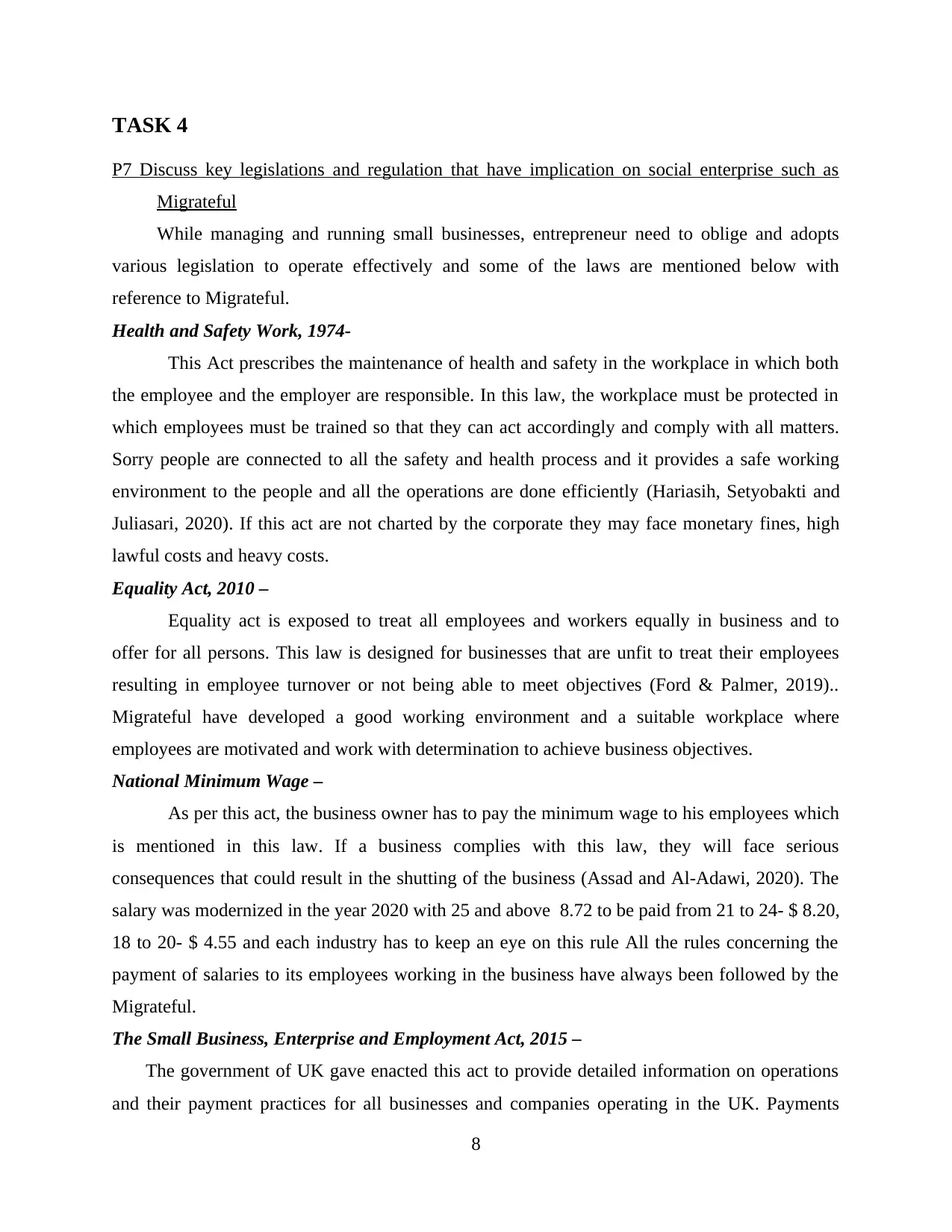
TASK 4
P7 Discuss key legislations and regulation that have implication on social enterprise such as
Migrateful
While managing and running small businesses, entrepreneur need to oblige and adopts
various legislation to operate effectively and some of the laws are mentioned below with
reference to Migrateful.
Health and Safety Work, 1974-
This Act prescribes the maintenance of health and safety in the workplace in which both
the employee and the employer are responsible. In this law, the workplace must be protected in
which employees must be trained so that they can act accordingly and comply with all matters.
Sorry people are connected to all the safety and health process and it provides a safe working
environment to the people and all the operations are done efficiently (Hariasih, Setyobakti and
Juliasari, 2020). If this act are not charted by the corporate they may face monetary fines, high
lawful costs and heavy costs.
Equality Act, 2010 –
Equality act is exposed to treat all employees and workers equally in business and to
offer for all persons. This law is designed for businesses that are unfit to treat their employees
resulting in employee turnover or not being able to meet objectives (Ford & Palmer, 2019)..
Migrateful have developed a good working environment and a suitable workplace where
employees are motivated and work with determination to achieve business objectives.
National Minimum Wage –
As per this act, the business owner has to pay the minimum wage to his employees which
is mentioned in this law. If a business complies with this law, they will face serious
consequences that could result in the shutting of the business (Assad and Al-Adawi, 2020). The
salary was modernized in the year 2020 with 25 and above 8.72 to be paid from 21 to 24- $ 8.20,
18 to 20- $ 4.55 and each industry has to keep an eye on this rule All the rules concerning the
payment of salaries to its employees working in the business have always been followed by the
Migrateful.
The Small Business, Enterprise and Employment Act, 2015 –
The government of UK gave enacted this act to provide detailed information on operations
and their payment practices for all businesses and companies operating in the UK. Payments
8
P7 Discuss key legislations and regulation that have implication on social enterprise such as
Migrateful
While managing and running small businesses, entrepreneur need to oblige and adopts
various legislation to operate effectively and some of the laws are mentioned below with
reference to Migrateful.
Health and Safety Work, 1974-
This Act prescribes the maintenance of health and safety in the workplace in which both
the employee and the employer are responsible. In this law, the workplace must be protected in
which employees must be trained so that they can act accordingly and comply with all matters.
Sorry people are connected to all the safety and health process and it provides a safe working
environment to the people and all the operations are done efficiently (Hariasih, Setyobakti and
Juliasari, 2020). If this act are not charted by the corporate they may face monetary fines, high
lawful costs and heavy costs.
Equality Act, 2010 –
Equality act is exposed to treat all employees and workers equally in business and to
offer for all persons. This law is designed for businesses that are unfit to treat their employees
resulting in employee turnover or not being able to meet objectives (Ford & Palmer, 2019)..
Migrateful have developed a good working environment and a suitable workplace where
employees are motivated and work with determination to achieve business objectives.
National Minimum Wage –
As per this act, the business owner has to pay the minimum wage to his employees which
is mentioned in this law. If a business complies with this law, they will face serious
consequences that could result in the shutting of the business (Assad and Al-Adawi, 2020). The
salary was modernized in the year 2020 with 25 and above 8.72 to be paid from 21 to 24- $ 8.20,
18 to 20- $ 4.55 and each industry has to keep an eye on this rule All the rules concerning the
payment of salaries to its employees working in the business have always been followed by the
Migrateful.
The Small Business, Enterprise and Employment Act, 2015 –
The government of UK gave enacted this act to provide detailed information on operations
and their payment practices for all businesses and companies operating in the UK. Payments
8
Paraphrase This Document
Need a fresh take? Get an instant paraphrase of this document with our AI Paraphraser
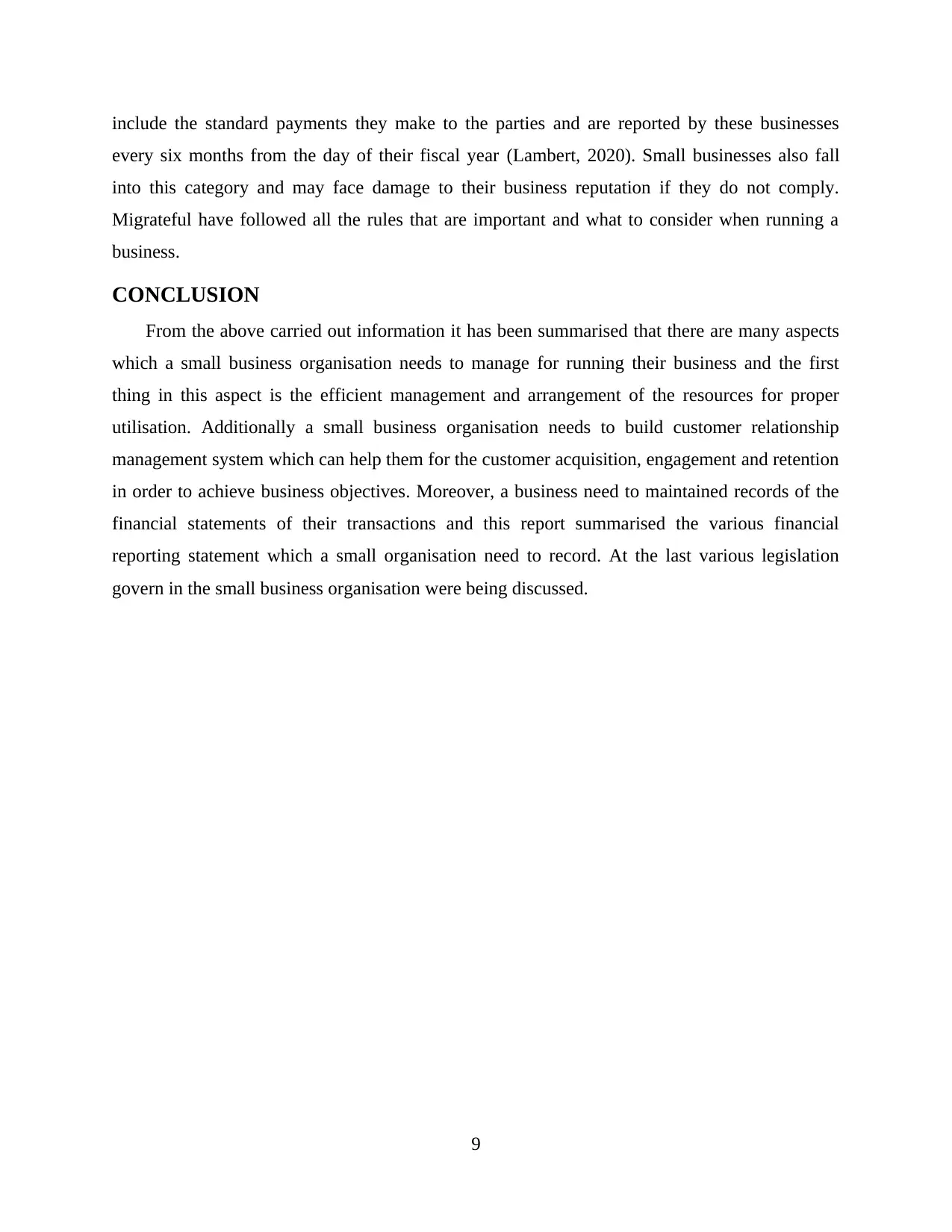
include the standard payments they make to the parties and are reported by these businesses
every six months from the day of their fiscal year (Lambert, 2020). Small businesses also fall
into this category and may face damage to their business reputation if they do not comply.
Migrateful have followed all the rules that are important and what to consider when running a
business.
CONCLUSION
From the above carried out information it has been summarised that there are many aspects
which a small business organisation needs to manage for running their business and the first
thing in this aspect is the efficient management and arrangement of the resources for proper
utilisation. Additionally a small business organisation needs to build customer relationship
management system which can help them for the customer acquisition, engagement and retention
in order to achieve business objectives. Moreover, a business need to maintained records of the
financial statements of their transactions and this report summarised the various financial
reporting statement which a small organisation need to record. At the last various legislation
govern in the small business organisation were being discussed.
9
every six months from the day of their fiscal year (Lambert, 2020). Small businesses also fall
into this category and may face damage to their business reputation if they do not comply.
Migrateful have followed all the rules that are important and what to consider when running a
business.
CONCLUSION
From the above carried out information it has been summarised that there are many aspects
which a small business organisation needs to manage for running their business and the first
thing in this aspect is the efficient management and arrangement of the resources for proper
utilisation. Additionally a small business organisation needs to build customer relationship
management system which can help them for the customer acquisition, engagement and retention
in order to achieve business objectives. Moreover, a business need to maintained records of the
financial statements of their transactions and this report summarised the various financial
reporting statement which a small organisation need to record. At the last various legislation
govern in the small business organisation were being discussed.
9
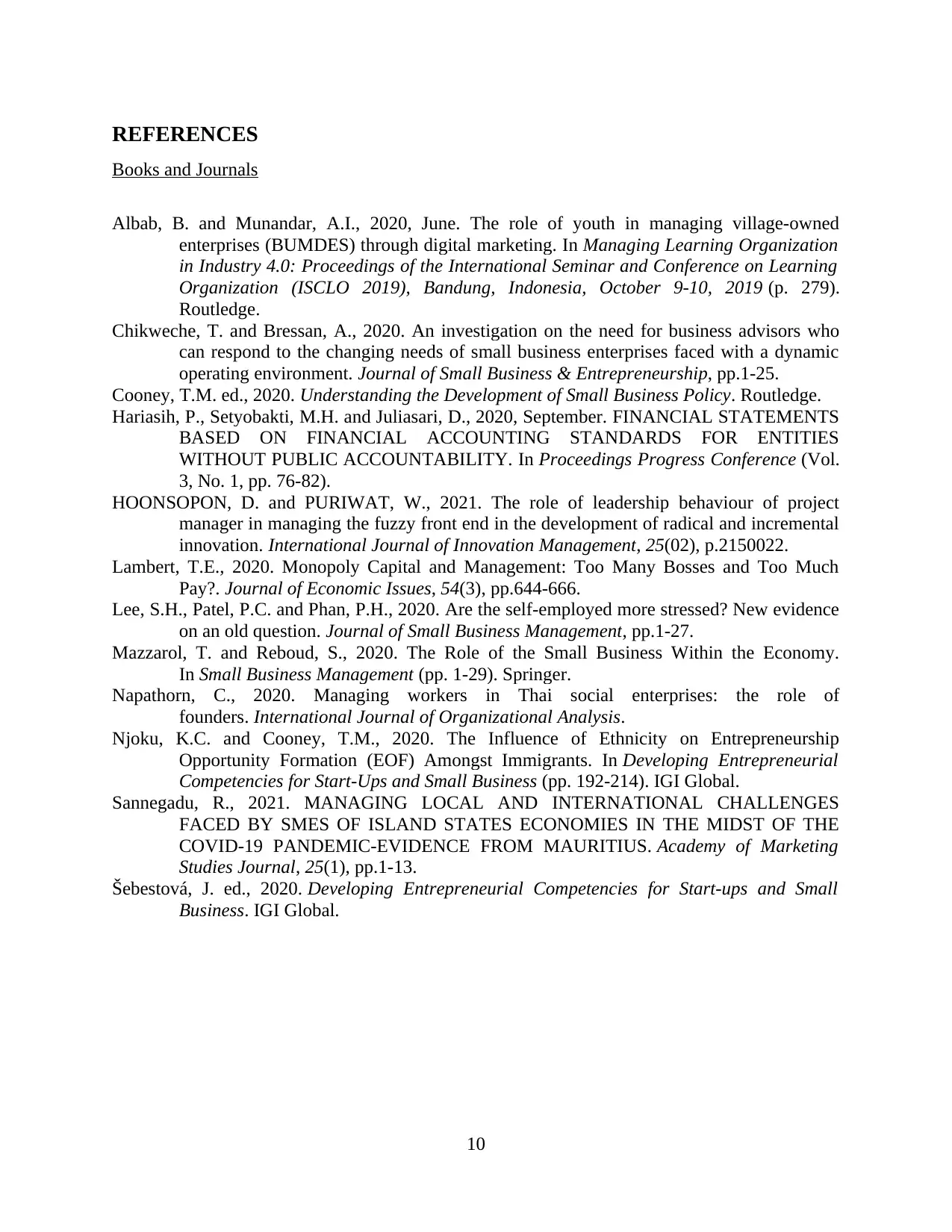
REFERENCES
Books and Journals
Albab, B. and Munandar, A.I., 2020, June. The role of youth in managing village-owned
enterprises (BUMDES) through digital marketing. In Managing Learning Organization
in Industry 4.0: Proceedings of the International Seminar and Conference on Learning
Organization (ISCLO 2019), Bandung, Indonesia, October 9-10, 2019 (p. 279).
Routledge.
Chikweche, T. and Bressan, A., 2020. An investigation on the need for business advisors who
can respond to the changing needs of small business enterprises faced with a dynamic
operating environment. Journal of Small Business & Entrepreneurship, pp.1-25.
Cooney, T.M. ed., 2020. Understanding the Development of Small Business Policy. Routledge.
Hariasih, P., Setyobakti, M.H. and Juliasari, D., 2020, September. FINANCIAL STATEMENTS
BASED ON FINANCIAL ACCOUNTING STANDARDS FOR ENTITIES
WITHOUT PUBLIC ACCOUNTABILITY. In Proceedings Progress Conference (Vol.
3, No. 1, pp. 76-82).
HOONSOPON, D. and PURIWAT, W., 2021. The role of leadership behaviour of project
manager in managing the fuzzy front end in the development of radical and incremental
innovation. International Journal of Innovation Management, 25(02), p.2150022.
Lambert, T.E., 2020. Monopoly Capital and Management: Too Many Bosses and Too Much
Pay?. Journal of Economic Issues, 54(3), pp.644-666.
Lee, S.H., Patel, P.C. and Phan, P.H., 2020. Are the self-employed more stressed? New evidence
on an old question. Journal of Small Business Management, pp.1-27.
Mazzarol, T. and Reboud, S., 2020. The Role of the Small Business Within the Economy.
In Small Business Management (pp. 1-29). Springer.
Napathorn, C., 2020. Managing workers in Thai social enterprises: the role of
founders. International Journal of Organizational Analysis.
Njoku, K.C. and Cooney, T.M., 2020. The Influence of Ethnicity on Entrepreneurship
Opportunity Formation (EOF) Amongst Immigrants. In Developing Entrepreneurial
Competencies for Start-Ups and Small Business (pp. 192-214). IGI Global.
Sannegadu, R., 2021. MANAGING LOCAL AND INTERNATIONAL CHALLENGES
FACED BY SMES OF ISLAND STATES ECONOMIES IN THE MIDST OF THE
COVID-19 PANDEMIC-EVIDENCE FROM MAURITIUS. Academy of Marketing
Studies Journal, 25(1), pp.1-13.
Šebestová, J. ed., 2020. Developing Entrepreneurial Competencies for Start-ups and Small
Business. IGI Global.
10
Books and Journals
Albab, B. and Munandar, A.I., 2020, June. The role of youth in managing village-owned
enterprises (BUMDES) through digital marketing. In Managing Learning Organization
in Industry 4.0: Proceedings of the International Seminar and Conference on Learning
Organization (ISCLO 2019), Bandung, Indonesia, October 9-10, 2019 (p. 279).
Routledge.
Chikweche, T. and Bressan, A., 2020. An investigation on the need for business advisors who
can respond to the changing needs of small business enterprises faced with a dynamic
operating environment. Journal of Small Business & Entrepreneurship, pp.1-25.
Cooney, T.M. ed., 2020. Understanding the Development of Small Business Policy. Routledge.
Hariasih, P., Setyobakti, M.H. and Juliasari, D., 2020, September. FINANCIAL STATEMENTS
BASED ON FINANCIAL ACCOUNTING STANDARDS FOR ENTITIES
WITHOUT PUBLIC ACCOUNTABILITY. In Proceedings Progress Conference (Vol.
3, No. 1, pp. 76-82).
HOONSOPON, D. and PURIWAT, W., 2021. The role of leadership behaviour of project
manager in managing the fuzzy front end in the development of radical and incremental
innovation. International Journal of Innovation Management, 25(02), p.2150022.
Lambert, T.E., 2020. Monopoly Capital and Management: Too Many Bosses and Too Much
Pay?. Journal of Economic Issues, 54(3), pp.644-666.
Lee, S.H., Patel, P.C. and Phan, P.H., 2020. Are the self-employed more stressed? New evidence
on an old question. Journal of Small Business Management, pp.1-27.
Mazzarol, T. and Reboud, S., 2020. The Role of the Small Business Within the Economy.
In Small Business Management (pp. 1-29). Springer.
Napathorn, C., 2020. Managing workers in Thai social enterprises: the role of
founders. International Journal of Organizational Analysis.
Njoku, K.C. and Cooney, T.M., 2020. The Influence of Ethnicity on Entrepreneurship
Opportunity Formation (EOF) Amongst Immigrants. In Developing Entrepreneurial
Competencies for Start-Ups and Small Business (pp. 192-214). IGI Global.
Sannegadu, R., 2021. MANAGING LOCAL AND INTERNATIONAL CHALLENGES
FACED BY SMES OF ISLAND STATES ECONOMIES IN THE MIDST OF THE
COVID-19 PANDEMIC-EVIDENCE FROM MAURITIUS. Academy of Marketing
Studies Journal, 25(1), pp.1-13.
Šebestová, J. ed., 2020. Developing Entrepreneurial Competencies for Start-ups and Small
Business. IGI Global.
10
⊘ This is a preview!⊘
Do you want full access?
Subscribe today to unlock all pages.

Trusted by 1+ million students worldwide
1 out of 12
Related Documents
Your All-in-One AI-Powered Toolkit for Academic Success.
+13062052269
info@desklib.com
Available 24*7 on WhatsApp / Email
![[object Object]](/_next/static/media/star-bottom.7253800d.svg)
Unlock your academic potential
Copyright © 2020–2025 A2Z Services. All Rights Reserved. Developed and managed by ZUCOL.





